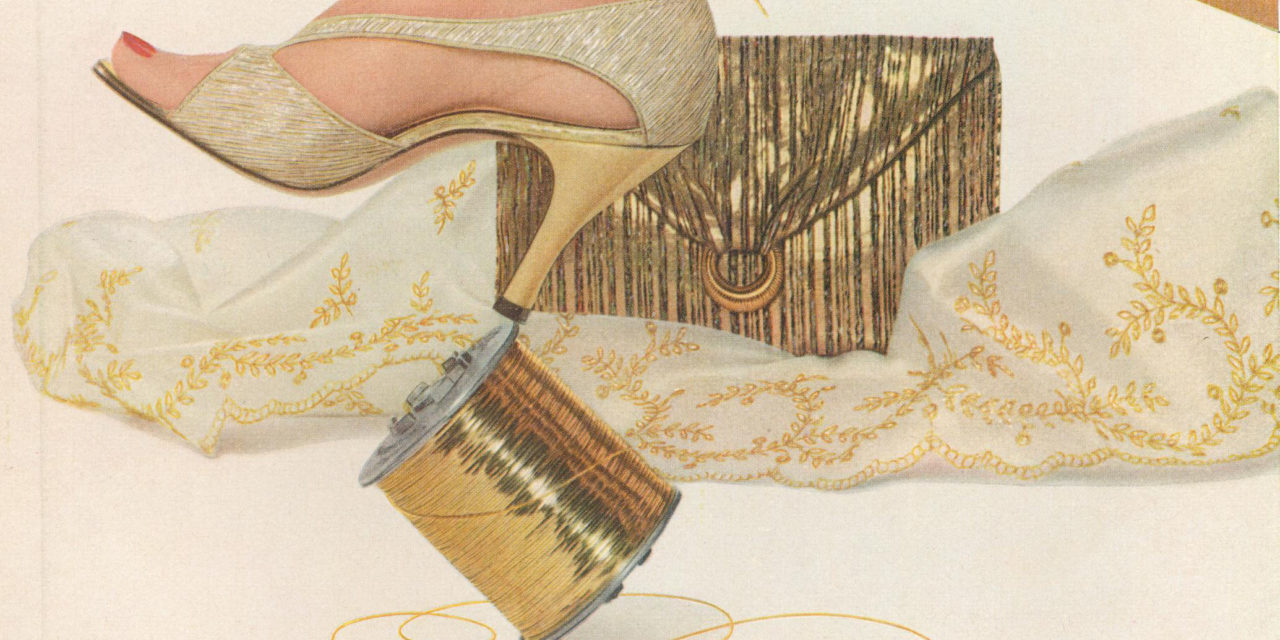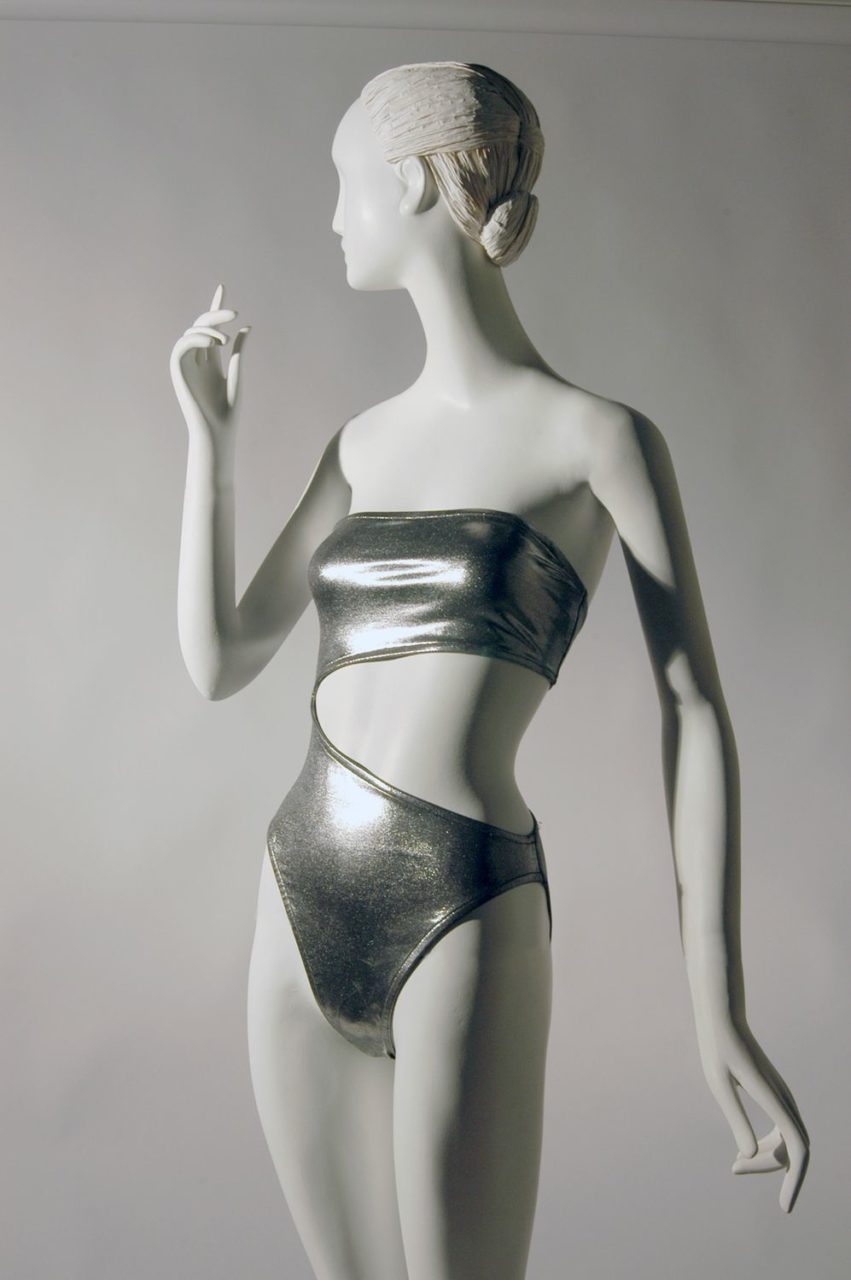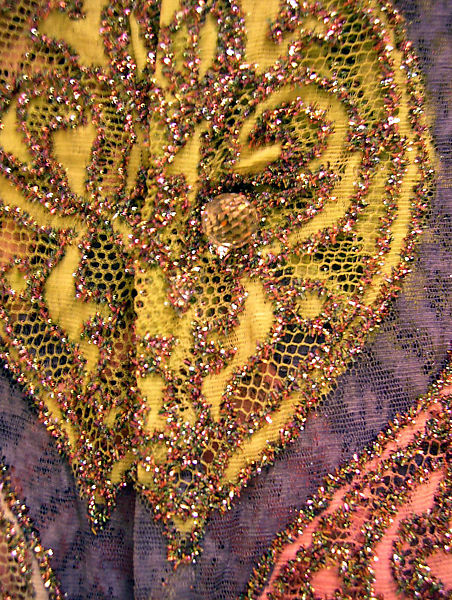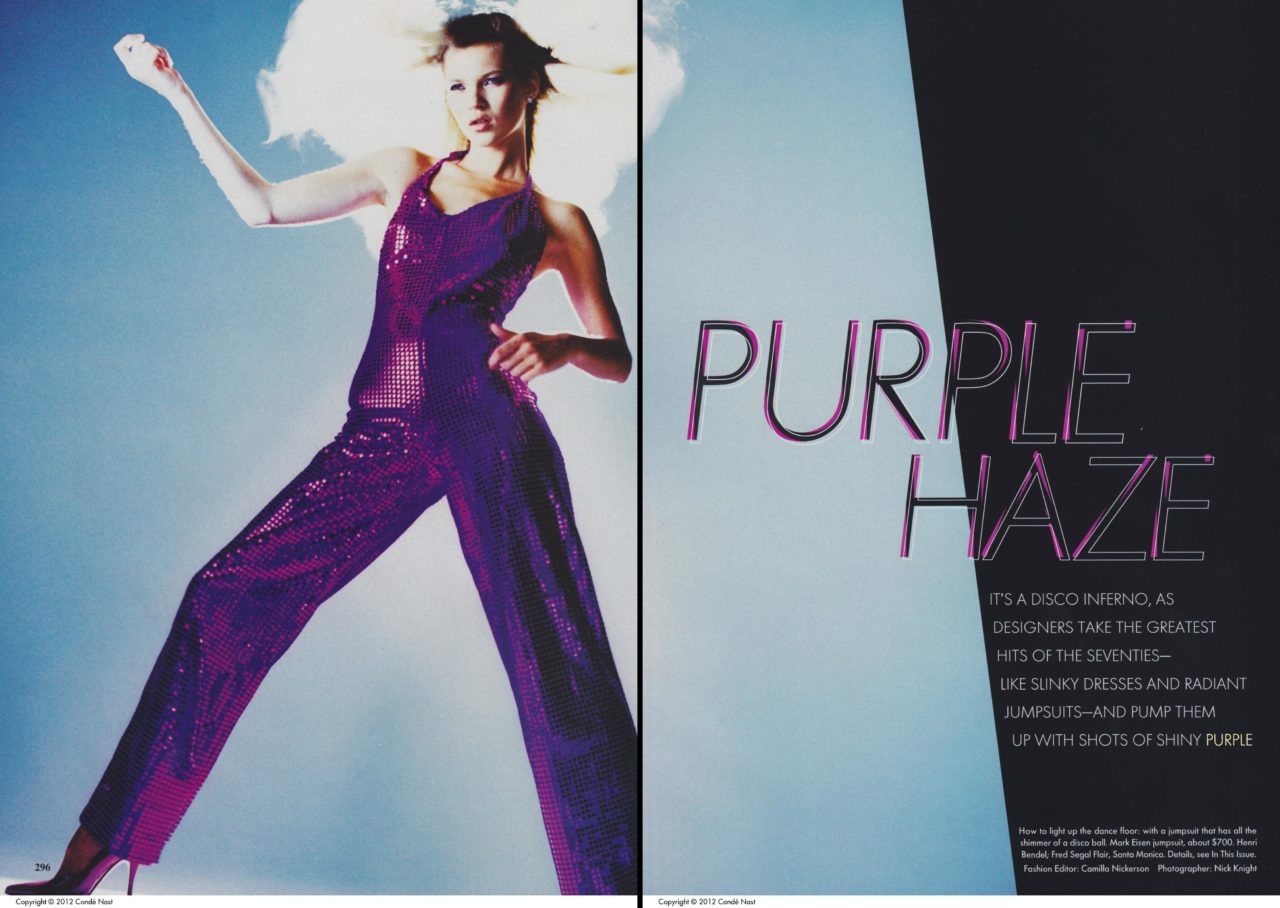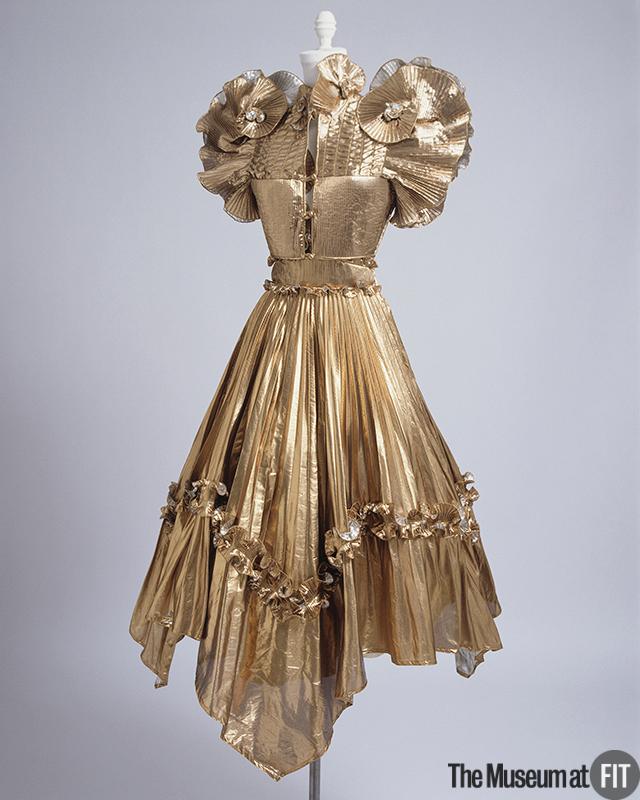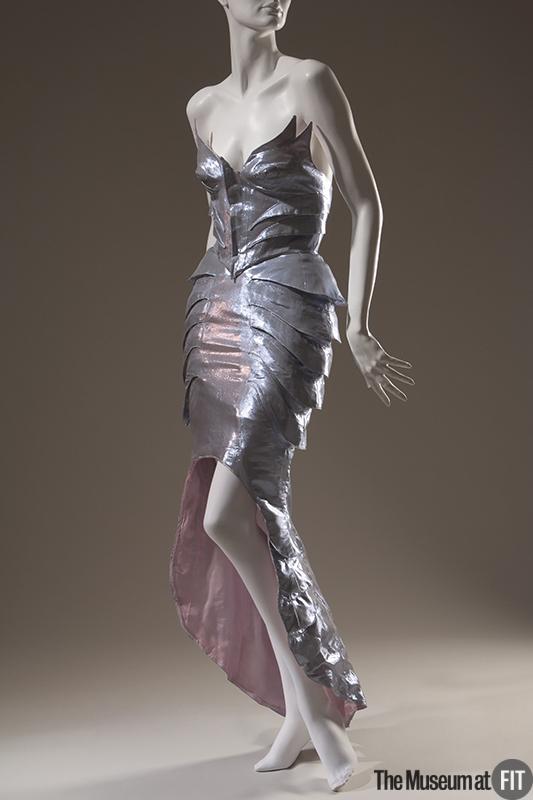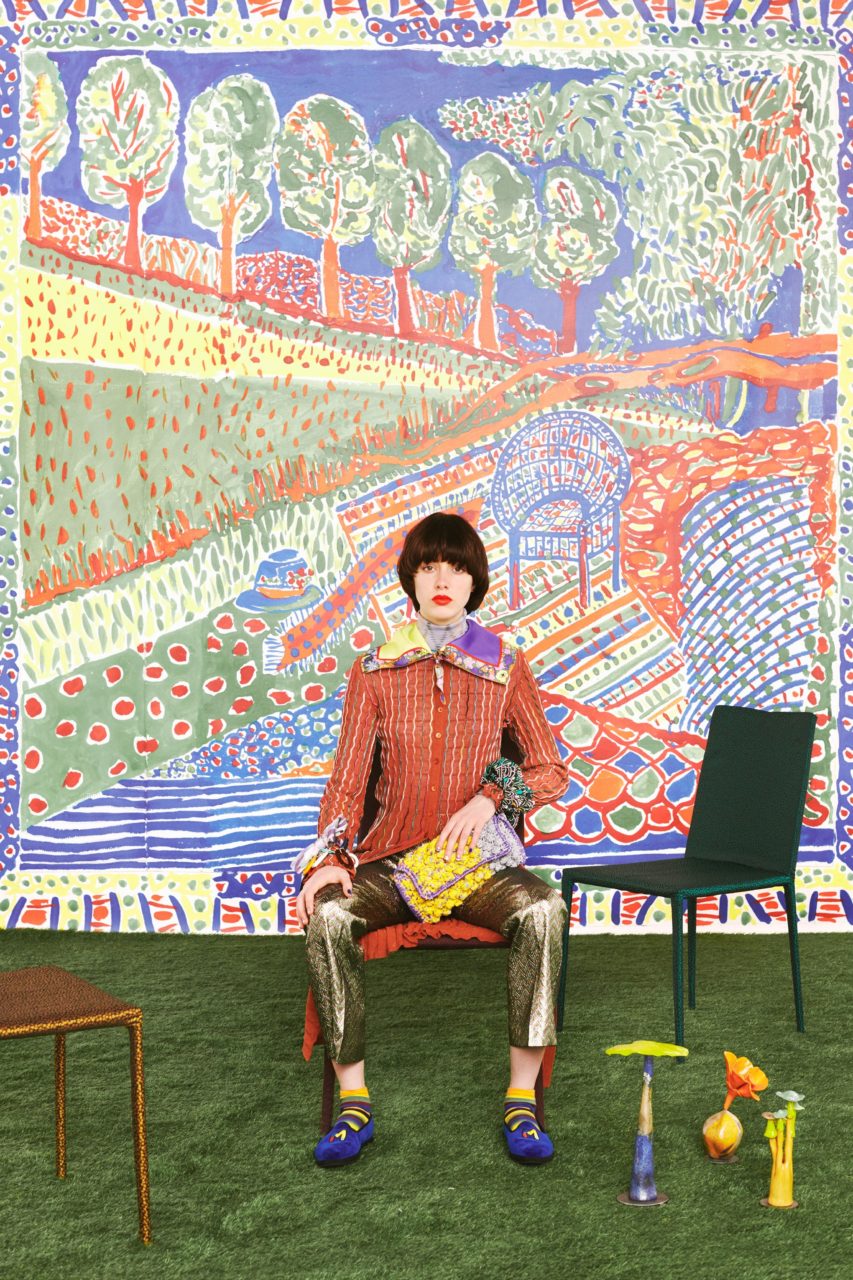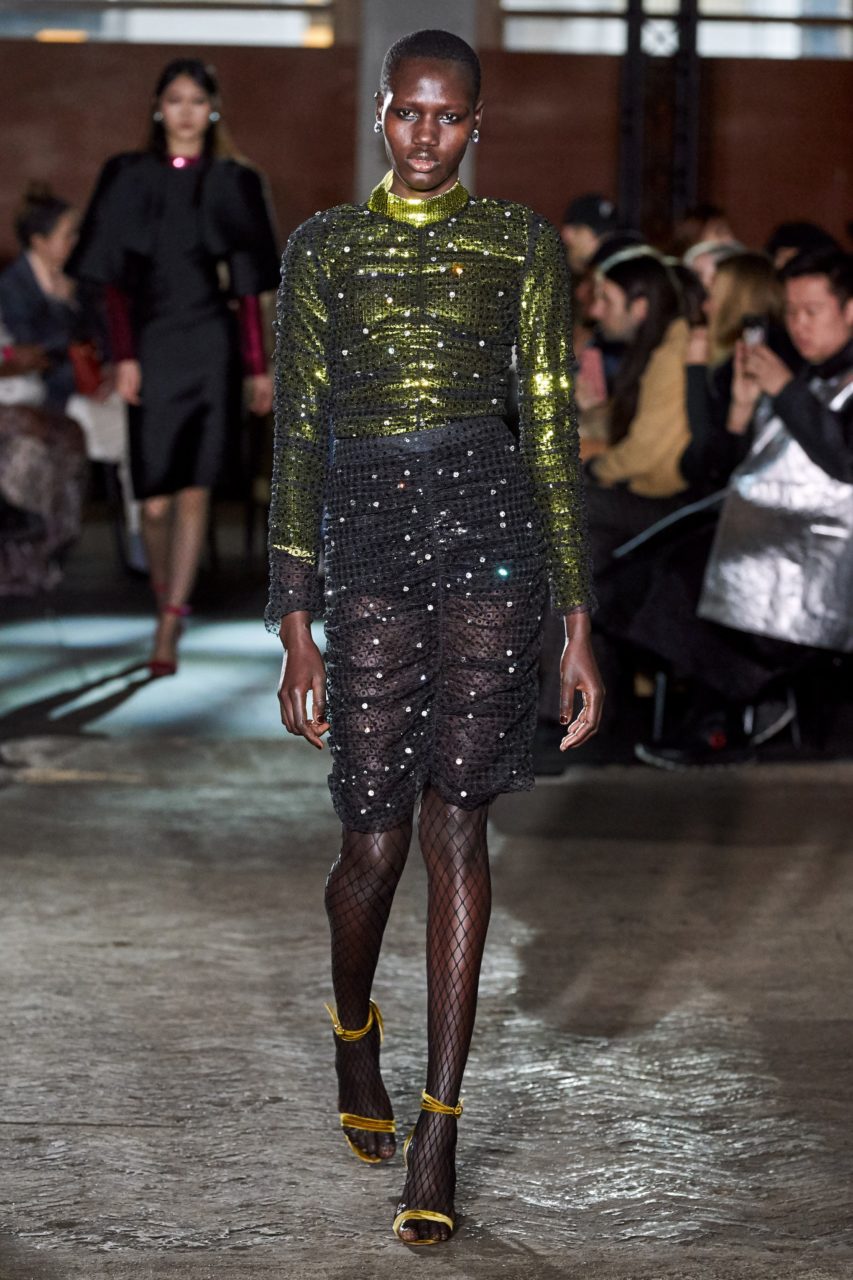A shiny synthetic fiber made of aluminum-coated plastic with a glittering metallic sheen.
The Details
In Fairchild’s Dictionary of Fashion (1988), Charlotte Mankey Calasibetta gives a technical definition of Lurex:
“Lurex; Trademark name of the American Dow Badische Company for a decorative metallic fiber and yarn which is made of aluminum-coated plastic to make it tarnish-proof.” (357)
The glimmering metallic effect of Lurex-woven fabrics imitated extremely costly fabrics woven with gold and silver thread, creating a much cheaper version of the same look. It is often used in knits, and the relative cheapness means that even casual garments like swimsuits can be made from it (Fig. 1). However, it is most well known for being used in evening and disco-wear.
In The Dictionary of Fashion History (2010), Valerie Cumming, C. W. Cunnington, and P. E. Cunnington explain further:
“Lurex: Period: 1940s onwards. Trademark name of the American Dow Badische Company for its metallic fibre yarn. Either woven or knitted with cotton, nylon, rayon, silk or wool fibers, lurex was and is made into garments, especially evening-wear.” (255)
While the Lurex brand has been around since 1946 and experienced a high point in the 70s, it is still used today, and “Lurex” can refer to both the fiber and the fabric made with it. In fact, the word is often used outside of its trademark to indicate similar treatments of a fiber; the ensemble in figure 2 is a good example of that. The specific brand Lurex was created in 1946, so the material creating the gold stripes in this c. 1935 garment cannot be “Lurex” – but it is referred to with that name anyway.
The 1954 Vogue advertisement in figure 3 depicts five items that all feature (real) Lurex in some way – even the Zentall metal bracelet, which is partially made of a Lurex fabric designed by Dorothy Liebes. One of Liebes’ textile samples can be seen in figure 4, where the Lurex is far less noticeable – proof that not every garment was completely covered in the fiber.
Fig. 1 - Calvin Klein (American, 1942-present). Woman's Bathing Suit, Resort 1989-90. Silver lurex knit; 48.3 cm long, bust 58.4 cm (19" long, bust 23 in). Philadelphia Museum of Art, 1997-175-32. Gift of Calvin Klein, 1997. Source: PMA
Fig. 2 - Muriel King (American, 1900-1977). Evening set, ca. 1935. Gray, brown and gold striped silk and gold lurex. New York: The Museum at FIT, 76.20.2. Gift of Mrs. Louise Morgan Hook, Mrs. Anne Morgan Simoneau and Mr. J. P. Morgan, II. Source: MFIT
Fig. 3 - I. Miller; Coblentz; Hirsch; Zentall; Dorothy Liebes; and Emily Wetherby for Henri Bendel. The Thread of the Story is LUREX, Nov. 15, 1954. Vogue, Vol. 124, Iss. 9 (Nov 15, 1954): 38. Source: Vogue
Fig. 4 - Dorothy Liebes (American, 1897–1972). Textile sample, ca. 1955–58. Cotton, lurex (aluminum foil, plastic coated); 21.6 × 16.5 cm (8 1/2 × 6 1/2 in). New York: The Metropolitan Museum of Art, 1973.129.70. Gift of Dorothy Liebes Design Inc., 1973. Source: MMA
Lurex was just as useful in the 1960s as it had been in the 1940s. In Nylon: The Story of a Fashion Revolution (2000), Susannah Handley describes the playfulness of Space Age fashion:
“During the 1960s… The great new message was the art could be enjoyable, ironic, and accessible… it could be anything, and so could fashion and design. Why not wear brash, shiny PVC, fake leather, ‘fun’ furs, glitzy Lurex, contoured Crimplene, heat-set acrylic slacks or sweaters made from plastic wool.” (112-113)
Mary Ellen Snodgrass gives a more extensive overview of Lurex in her book World Clothing and Fashion (2015):
“In the 1940s, Lurex, a weave of cotton and metallic yarns, outpaced satin as a flashy fabric for stage costumes and men’s tuxedo lapels, cummerbunds, and bowties.” (504)
“The film Saturday Night Fever (1977) built demand for sparkly Lurex disco dresses and unisex bell bottoms… Cartoonists and fashion mavens ridiculed stretch pants, disco flash, and the gaudy, artificial leisure suit.” (460)
The c. 1975 Halston cocktail dress in figure 5 is a more restrained example of seventies disco style. Snodgrass continues:
“The 1980s saw the incorporation of iridescent Lurex, metallic laminated nylon and polyester threads that boosted the appeal of sportswear and dance wear, such as the stainless steel-threaded mohair and realistic plastic skin bodice designed by fabric engineer Issey Miyake. Distributed from Paris and London, Lurex yarns added glitter to knitting, embroidery, and lace. Designers in New York, Milan, and Melbourne popularized Lurex among youthful consumers in metallic tones as well as red, violet, green, yellow, blue, and beige. Soft-glazed Lurex yielded sweater yarns for light-weight, body-hugging knits.” (258)
While Lurex is most commonly imagined in a gold or silver look, garments can be any color, seen in this closeup from a 1969-70 James Galanos ensemble (Fig. 6).
Katerina Pantelides explains that Lurex experienced a resurgence in popularity in the 1970s and 1990s in “Dancewear on the Catwalk, 1970s–2000s” (2015):
“Disco clothing was often made from lustrous synthetic fabrics including lurex and Lycra. Dominant garments included flares, which emphasized dance movement in their tight fit over the buttocks and thighs, jumpsuits, and platform shoes and boots for both men and women.”
This fashion was far-reaching. Pantelides continues, describing an outfit seen in figure 7:
“1970s revivalism in the mid-1990s heralded manifestations of disco style on the catwalk. Nick Knight’s shoot “Purple Haze” featured Kate Moss in updated, exclusively purple disco garments. These included a sequined lurex halter jumpsuit by Mark Eisen.”
In her article “Swimwear on the Catwalk, 1980-2000” (2015), Ciara Phipps explains that lurex is often used in high-end designer swimwear.
“One of the clearest and most symbolic ways luxury manifested itself in swimwear design was the use of gold. This gold tended to come as high-shine satins or Lurex jerseys in tones from the palest of golds to the richest of bronzes. Designers such as Gucci, Armani, and Hermès enjoyed success with this look.”
Lurex consistently experienced comebacks in previous styles, like the full-coverage gold seen in the 1981 Zandra Rhodes dress in figure 8. Haute couture designers fell back on it in the eighties and nineties for flash and bling (Fig. 9), a trend that has continued into the new millennium.
Fig. 5 - Halston (American, 1932–1990). Cocktail dress, ca. 1975. Lurex. New York: The Metropolitan Museum of Art, 1993.423.3a, b. Gift of Miriam W. Coletti, 1993. Source: MMA
Fig. 6 - James Galanos (American, 1924–2016). Evening ensemble, Fall/winter 1969-70. Silk, lurex. New York: The Metropolitan Museum of Art, 1995.587.4a–c. Gift of Laura Johnson, Esq., 1995. Source: MMA
Fig. 7 - Mark Eisen (South African, 1958-present). Purple Haze, Nov. 1, 1994. Vol. 184, Iss. 11, (Nov 1, 1994): 296-297. Photo: Nick Knight. Source: ProQuest
Fig. 8 - Zandra Rhodes (English, 1940-present). Evening set, 1981. Lamé fabric, assumed to be lurex fiber. New York: The Museum at FIT, 91.158.1. Gift of Mr. Bouke De Vries. Source: MFIT
Fig. 9 - Thierry Mugler (French, 1948-present). Evening set, Spring 1989. Polyester and lurex blend. New York: The Museum at FIT, 2011.13.1. Museum purchase. Source: MFIT
Its Afterlife
Lurex has experienced a new surge of popularity in 2020. Couture houses including Paco Rabanne, M Missoni, and Huishan Zhang included it in their ensembles. Paco Rabanne’s Resort 2020 collection used a glittering silver-pink Lurex tube knit for skirts and sweaters (Fig. 10), but Missoni’s high-waisted Lurex slacks (Fig. 11) and Zhang’s black-and-gold Lurex ruched bodysuit (Fig. 12) suggests that perhaps the third age of Lurex fashion is characterized by subtler touches, instead of complete metallic garments.
Fig. 10 - Paco Rabanne (Spanish, 1934-present). Look 6, Resort 2020. Photo: Theo Sion / Courtesy of Paco Rabanne. Source: Vogue
Fig. 11 - Margherita Missoni (Italian, 1983-present). Look 6, Pre-Fall 2020. Courtesy of M Missoni. Source: Vogue
Fig. 12 - Huishan Zhang (Chinese, Before 1993-present). Black ruched Lurex bodysuit, Fall 2020 RTW. Photo: Alessandro Lucioni. Source: Vogue
References:
- Calasibetta, Charlotte Mankey. “Lurex.” In Fairchild’s Dictionary of Fashion, 2nd ed. New York: Fairchild Publications, 1988. http://www.worldcat.org/oclc/17932099
- Cumming, Valerie, C. Willett Cunnington, and Phillis Cunnington. The Dictionary of Fashion History. Oxford: Berg, 2010. http://www.worldcat.org/oclc/973647097
- Handley, Susannah. Nylon: The Story of a Fashion Revolution: A Celebration of Design from Art Silk to Nylon and Thinking Fibres. Baltimore, MD: Johns Hopkins University Press, 2000. http://www.worldcat.org/oclc/41488728
- Pantelides, Katerina. “Dancewear on the Catwalk, 1970s–2000s.” In Fashion Photography Archive. London: Bloomsbury, 2015. Accessed October 30, 2018. http://dx.doi.org/10.5040/9781474260428-FPA191
- Phipps, Ciara. “Swimwear on the Catwalk, 1980–2000.” In Fashion Photography Archive. London: Bloomsbury, 2015. Accessed October 31, 2018. http://dx.doi.org/10.5040/9781474260428-FPA273
- Snodgrass, Mary E. World Clothing and Fashion: An Encyclopedia of History, Culture, and Social Influence. New York: Routledge, 2015. http://www.worldcat.org/oclc/908851801

